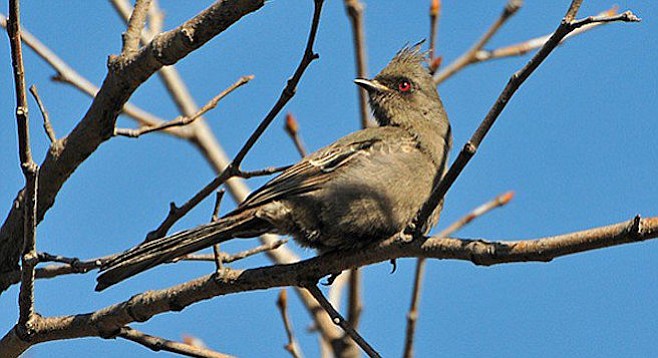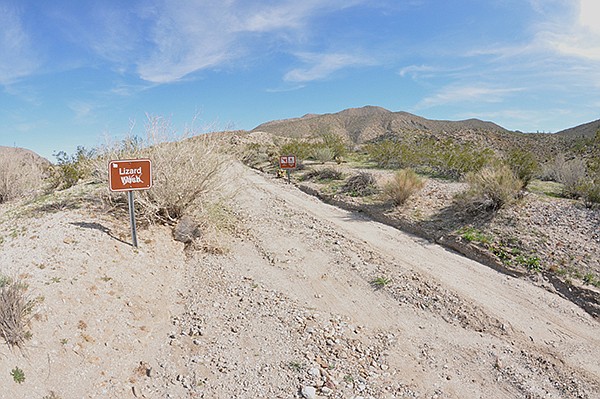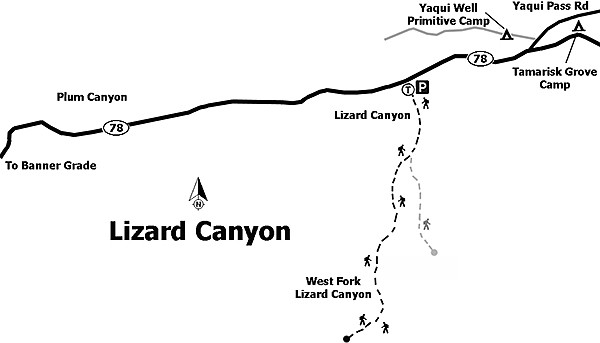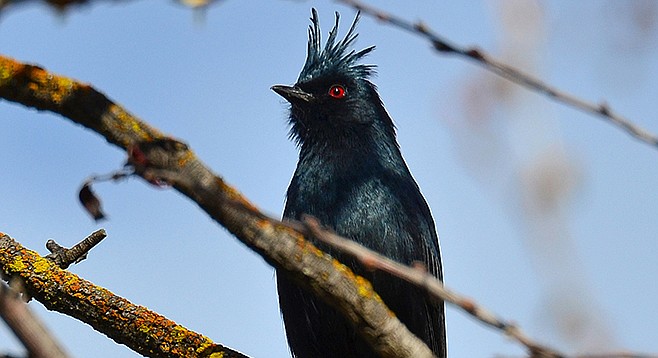 Facebook
Facebook
 X
X
 Instagram
Instagram
 TikTok
TikTok
 Youtube
Youtube

Rangers began exploring Anza-Borrego Desert State Park systematically during the 1950s. They kept detailed logs and recorded their findings. When a wash or canyon did not have a name, they assigned one. Ranger Frank Fairchild recorded that a lizard was sighted running across the wash, and so this canyon and wash were named Lizard Canyon.

The hike begins 0.6 mile from the entrance to the wash, assuming you have a high clearance or 4WD vehicle. If not, park your vehicle at the entrance. Your hike will be 1.2 miles longer or 4.7 miles out and back if you begin from the wash entrance. The fork in the road at 0.6 mile is your trailhead marker.
Begin the hike from the fork, taking the right (southwest) fork. The trail is a big open wash dotted with desert perennials that include ocotillo, chuparosa, teddy-bear cholla, creosote, and brittlebush. If hiking in spring after good winter rains, the surrounding hills may be covered with a mosaic of colorful annuals.
As you make your way up the wash, granitic inclusions become a prominent feature, telling a story of Lizard Canyon’s geologic past. Muscovite and biotite mica reflect the desert sunlight all around the canyon with reflections as far as the eyes can see.

At about one mile into the hike, the wash changes, becoming more narrow. With this change comes a change in geology and plant life. The most dominant plants become desert lavender and juniper. The aromas fill the air in this narrow, rocky space. Green vegetation may blanket the steep canyon walls, making this a perfect rest spot. Relax under a juniper and listen for birds of the Anza-Borrego desert, such as Gambel’s quail. You may also see the tubby gray quail darting in and out of some of the desert shrubs with some of his companions. The quail is gregarious and prefers walking or running to flying. Look for its comma-shaped top notch. Males have a rufous crest, a black face, and a creamy belly with a black patch. The flanks are chestnut with white stripes. If you don’t see the quail, you might hear its many different clucking and crowing sounds that include “ka-kAA.”

Look up and you might see a glossy black bird with a crest and a distinct white wing patch that is visible when it flies. That would be a phainopepla, a flycatcher that is often seen where desert mistletoe is growing, as mistletoe berries are one of its favorite foods. The female is not as distinct-looking, as it is gray with a lighter gray wing patch.
Just a little farther, at about 1.75 miles, is a good stopping point as soft sand makes the trail just a little more difficult. Before returning, there are many channels to explore in this canyon for the spirited hiker. Make sure to take notice and enjoy the metamorphic rocks at mile 1.75. Banded schist take over, making a geologic paradise for any geo-enthusiast. Layers of strata bend and twist among the surrounding walls, with an array of orange, black, gray, and white aggregate minerals. It may be tempting to gather the pocket-sized geologic wonders, but it is illegal to do so. Everything within Anza-Borrego Desert State Park is protected. Take only memories and photographs on your way back to your vehicle.
Distance from downtown San Diego: 79 miles. Allow 2 hours driving time (Anza-Borrego Desert State Park). Drive to Julian and follow SR-78 east 17.3 miles down Banner Canyon, past Scissors Crossing, and through Sentenac Canyon to the turnout on the right (south) for the signed Lizard Canyon, about 6 miles past Scissors Crossing. Park at the entrance. If you have a high clearance or 4WD vehicle, proceed up the wash 0.6 mile to a road fork and park just off the road.
Hiking length: 3.5 miles out and back.
Difficulty: Moderate hike with little elevation gain.
est time to visit is December through April. Dogs (on leashes) and mountain bikes allowed on designated roads only and not on any trails. No facilities.


Rangers began exploring Anza-Borrego Desert State Park systematically during the 1950s. They kept detailed logs and recorded their findings. When a wash or canyon did not have a name, they assigned one. Ranger Frank Fairchild recorded that a lizard was sighted running across the wash, and so this canyon and wash were named Lizard Canyon.

The hike begins 0.6 mile from the entrance to the wash, assuming you have a high clearance or 4WD vehicle. If not, park your vehicle at the entrance. Your hike will be 1.2 miles longer or 4.7 miles out and back if you begin from the wash entrance. The fork in the road at 0.6 mile is your trailhead marker.
Begin the hike from the fork, taking the right (southwest) fork. The trail is a big open wash dotted with desert perennials that include ocotillo, chuparosa, teddy-bear cholla, creosote, and brittlebush. If hiking in spring after good winter rains, the surrounding hills may be covered with a mosaic of colorful annuals.
As you make your way up the wash, granitic inclusions become a prominent feature, telling a story of Lizard Canyon’s geologic past. Muscovite and biotite mica reflect the desert sunlight all around the canyon with reflections as far as the eyes can see.

At about one mile into the hike, the wash changes, becoming more narrow. With this change comes a change in geology and plant life. The most dominant plants become desert lavender and juniper. The aromas fill the air in this narrow, rocky space. Green vegetation may blanket the steep canyon walls, making this a perfect rest spot. Relax under a juniper and listen for birds of the Anza-Borrego desert, such as Gambel’s quail. You may also see the tubby gray quail darting in and out of some of the desert shrubs with some of his companions. The quail is gregarious and prefers walking or running to flying. Look for its comma-shaped top notch. Males have a rufous crest, a black face, and a creamy belly with a black patch. The flanks are chestnut with white stripes. If you don’t see the quail, you might hear its many different clucking and crowing sounds that include “ka-kAA.”

Look up and you might see a glossy black bird with a crest and a distinct white wing patch that is visible when it flies. That would be a phainopepla, a flycatcher that is often seen where desert mistletoe is growing, as mistletoe berries are one of its favorite foods. The female is not as distinct-looking, as it is gray with a lighter gray wing patch.
Just a little farther, at about 1.75 miles, is a good stopping point as soft sand makes the trail just a little more difficult. Before returning, there are many channels to explore in this canyon for the spirited hiker. Make sure to take notice and enjoy the metamorphic rocks at mile 1.75. Banded schist take over, making a geologic paradise for any geo-enthusiast. Layers of strata bend and twist among the surrounding walls, with an array of orange, black, gray, and white aggregate minerals. It may be tempting to gather the pocket-sized geologic wonders, but it is illegal to do so. Everything within Anza-Borrego Desert State Park is protected. Take only memories and photographs on your way back to your vehicle.
Distance from downtown San Diego: 79 miles. Allow 2 hours driving time (Anza-Borrego Desert State Park). Drive to Julian and follow SR-78 east 17.3 miles down Banner Canyon, past Scissors Crossing, and through Sentenac Canyon to the turnout on the right (south) for the signed Lizard Canyon, about 6 miles past Scissors Crossing. Park at the entrance. If you have a high clearance or 4WD vehicle, proceed up the wash 0.6 mile to a road fork and park just off the road.
Hiking length: 3.5 miles out and back.
Difficulty: Moderate hike with little elevation gain.
est time to visit is December through April. Dogs (on leashes) and mountain bikes allowed on designated roads only and not on any trails. No facilities.
Comments